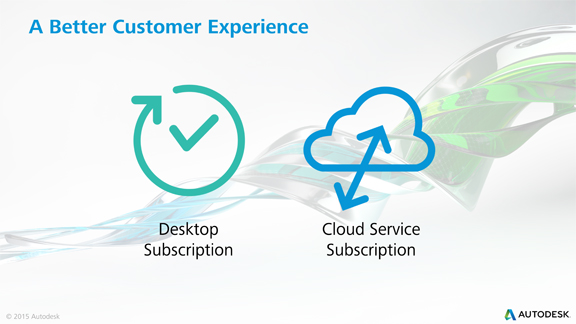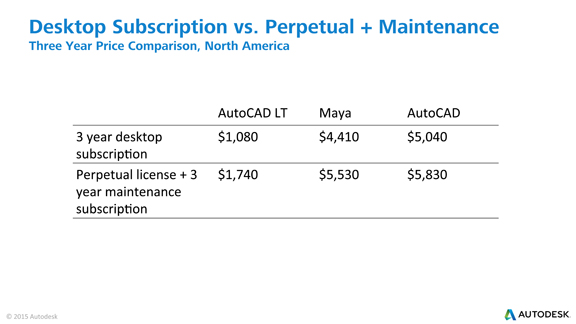
Autodesk announces cutoff date for availability of desktop perpetual licensing.
Latest News
February 4, 2015
 Autodesk announces cutoff date for availability of desktop perpetual licensing.
Autodesk announces cutoff date for availability of desktop perpetual licensing. Price comparison chart Autodesk uses to illustrate that subscription is a better alternative for customers.
Price comparison chart Autodesk uses to illustrate that subscription is a better alternative for customers.Autodesk is drawing a line in the sand, a definitive cutoff for the availability of perpetual desktop licenses.
“New commercial seats of most standalone desktop software products will be available only by Desktop Subscription beginning February 1, 2016,” the company announced today. The move is part of is transition to a subscription-only model.
Andrew Anagnost, sr. VP and industry strategist for Autodesk, remarked, “The move to cloud, mobile, and social platforms for software companies is as profound as the move from mainframe to desktop computers. If we want to be relevant to our customers in the new world, we have to be moving toward a pure cloud-based, subscription-based company.” He went so far as to declare, “All successful software companies in the future will be cloud companies.”
Autodesk, best known for its flagship design and drafting software AutoCAD, once used perpetual desktop licenses as the standard approach for its design, engineering, and animation software titles. But in 2009, Autodesk began experimenting with running cloud-hosted CAD program remotely from thin clients and browsers.
Project Twitch, a technology preview at the time, let you remotely run Autodesk Inventor, AutoCAD, and Autodesk Revit Architecture from a thin client, without installing the software locally. (Read “AU 2009: Cloudy with a Chance of Twitch,” December 2009.)
In early 2012, Autodesk launched its PLM offerings under the PLM 360 brand, delivering them as SaaS (software as a service) subscriptions. In late 2013, Autodesk introduced new licensing models, such as monthly rental option, for some of its titles. These preceding moves prepare the company for what it ultimately wants to implement—cloud-hosted software offerings, delivered as on-demand subscriptions.
February 1, 2016, marks the end of “perpetual licenses for standalone desktop products,” clarified Anagnost. “The suites [such as Building Design Suite, Product Design Suite, Entertainment Creation Suite] will continue to be available as standalone desktop products for some time, but that won’t last forever.”
Customers with perpetual licenses purchased prior to the cutoff date can continue to use their products with support from Autodesk. If these customers are on maintenance contract, Autodesk is expected to keep their perpetual desktop titles current with updates.
The cloud-hosted subscription model allows Autodesk to deliver incremental updates soon as they become available, Anagnost pointed out. Customer preferences and customizations can also be stored online, he added. Furthermore, he explained that over time, perpetual license with maintenance costs more than subscription (see chart above).
Utility agencies, architecture firms, and manufacturers that have built their workflows and processes around Autodesk products would have one-year lead time to prepare for the transition.
Whereas some rivals offering rental and subscription software demand annual commitment, Anagnost said Autodesk subscriptions are month to month, with the option to cancel anytime.
“Paying month to month costs more [over time] than annual subscription, but we’re finding that some customers stay on that—12, 13, 14 months, and so on—because it’s just better for them,” said Anagnost, “because, when the project stream dries up, they have the option to cancel.”
Upon cancellation of the subscription, the desktop software becomes inactive in some cases and becomes viewing-only products in others.
With a long history of desktop product sold under perpetual licenses, Autodesk currently has more customers on perpetual desktop licenses than subscription licenses, but the company expects the ratio to shift, eventually leading to subscription only.
Subscribe to our FREE magazine, FREE email newsletters or both!
Latest News
About the Author
Kenneth Wong is Digital Engineering’s resident blogger and senior editor. Email him at [email protected] or share your thoughts on this article at digitaleng.news/facebook.
Follow DE





